|
|
Canku Ota |
|
|
(Many Paths) |
||
|
An Online Newsletter Celebrating Native America |
||
|
December 14, 2002 - Issue 76 |
||
|
|
||
|
Why the North Star Stands Still |
||
|
Paiute Legend
|
||
|
|
 Long,
long ago, when the world was young, the People of the Sky were so restless
and travelled so much that they made trails in the heavens. Now, if
we watch the sky all through the night, we can see which way they go. Long,
long ago, when the world was young, the People of the Sky were so restless
and travelled so much that they made trails in the heavens. Now, if
we watch the sky all through the night, we can see which way they go.
But one star does not travel. That is the North Star. He cannot travel. He cannot move. When he was on the earth long, long ago, he was known as Na-gah, the mountain sheep, the son of Shinoh. He was brave, daring, sure-footed, and courageous. His father was so proud of him and loved him so much that he put large earrings on the sides of his head and made him look dignified, important, and commanding. Every day, Na-gah was climbing, climbing, climbing. He hunted for the roughest and the highest mountains, climbed them, lived among them, and was happy. Once in the very long ago, he found a very high peak. Its sides were steep and smooth, and its sharp peak reached up into the clouds. Na-gah looked up and said, "I wonder what is up there. I will climb to the very highest point." Around and around the mountain he travelled, looking for a trail. But he could find no trail. There was nothing but sheer cliffs all the way around. This was the first mountain Na-gah had ever seen that he could not climb.
Again and again he walked around the mountain, stopping now and then to peer up the steep cliff, hoping to see a crevice on which he could find footing. Again and again, he went up as far as he could, but always had to turn around and come down. At last he found a big crack in a rock that went down, not up. Down he went into it and soon found a hole that turned upward. His heart was made glad. Up and up he climbed. Soon it became so dark that he could not see, and the cave was full of loose rocks that slipped under his feet and rolled down. Soon he heard a big, fearsome noise coming up through the shaft at the same time the rolling rocks were dashed to pieces at the bottom. In the darkness he slipped often and skinned his knees. His courage and determination began to fail. He had never before seen a place so dark and dangerous. He was afraid, and he was also very tired. "I will go back and look again for a better place to climb," he said to himself. "I am not afraid out on the open cliffs, but this dark hole fills me with fear. I'm scared! I want to get out of here!"
After a long climb, he saw a little light, and he knew that he was coming out of the hole. "Now I am happy," he said aloud. "I am glad that I really came up through that dark hole." Looking around him, he became almost breathless, for he found that he was on the top of a very high peak! There was scarcely room for him to turn around, and looking down from this height made him dizzy. He saw great cliffs below him, in every direction, and saw only a small place in which he could move. Nowhere on the outside could he get down, and the cave was closed on the inside.., "Here I must stay until I die," he said. "But I have climbed my mountain! I have climbed my mountain at last! He ate a little grass and drank a little water that he found in the holes in the rocks. Then he felt better. He was higher than any mountain he could see and he could look down on the earth, far below him.
"I will not let my brave son die. I will turn him into a star, and he can stand there and shine where everyone can see him. He shall be a guide mark for all the living things on the earth or in the sky."
Besides Na-gah, other mountain sheep are in the sky. They are called "Big Dipper" and "Little Dipper." They too have found the great mountain and have been challenged by it. They have seen Na- gah standing on its top, and they want to go on up to him. Shinoh, the father of North Star, turned them into stars, and you may see them in the sky at the foot of the big mountain. Always they are travelling. They go around and around the mountain, seeking the trail that leads upward to Na-gah, who stands on the top. He is still the North Star. Print
and Color Your Own Bighorn Mountain Sheep |
|
|
|
Bighorn Mountain Sheep |
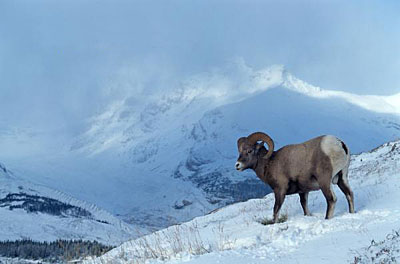 Few
animals are so well adapted to extremes of elevation and temperature
as the magnificent wild sheep of western North America's mountain rangelands.
Their range extends from the snowfields of the Canadian Rockies to below
sea level, on the desert floor of Death Valley, California, and from
Alaska all the way to northern Mexico. Few
animals are so well adapted to extremes of elevation and temperature
as the magnificent wild sheep of western North America's mountain rangelands.
Their range extends from the snowfields of the Canadian Rockies to below
sea level, on the desert floor of Death Valley, California, and from
Alaska all the way to northern Mexico. The wild, or mountain, sheep is a stocky, hoofed mammal, about one and a half times as large as a domestic sheep. The most distinctive characteristic of the males is their massive horns, which spiral back, out, and then forward, in an arc. Adult females have slightly curved horns about 30 cm long. The wild sheep was mentioned as early as 1540 by the Spanish explorer Coronado, who saw them in the vicinity of California. He described them as "Sheep as big as a Horse, with very large horns and little tails. I have seen some of their horns, the size of which was something to marvel at." It was the intrepid geographer David Thompson and his companion, Duncan McGillivray, who collected and preserved the first specimen of our native bighorn in 1800, near the remote upper reaches of the Bow River, just east of what is now Banff National Park. In the years that followed, the North American wild sheep became known the world round as one of the finest and most coveted of big game trophies. Their inaccessible habitat and their alertness and speed gave any hunter who bagged one a genuine feeling of achievement. Origin
and distribution When the great glaciers of the ice age inched south from polar centres, those animals became isolated in two ice-free areas, or refugia, one in central Alaska and the other south of the Columbia and Snake Rivers, in the United States. Sheep in the Alaska refugium evolved into the slender-horned Dall sheep (Ovis dalli), those farther south into the heavy-horned Rocky Mountain and desert bighorns (Ovis canadensis). Physical
characteristics The front hoofs of mountain sheep are slightly larger than the hind, but both leave a print that is almost rectangular. A hard rim around the outer edge of each hoof surrounds a softer, concave ( curving in ) area in the middle, giving excellent traction on rocky terrain. Mountain sheep are very agile, being second only to mountain goats in their ability to climb steep terrain. However, the goat is more of a climber or "walker", whereas the sheep, which bounds like a mule deer, can move much faster. Horns of a Rocky Mountain bighorn sheep measure up to 125 cm in length and 460 mm in circumference at the base. They normally form a tight curl close to the face and are often blunt at the tips. The horns of Dall and Stone sheep are about the same length but are more slender and widely flaring, and usually pointed at the tips. The maximum circumference at the base of the Dall horn is 400 mm. The two horns of a male, with their cones, may weigh over 13 kg. These horns grow from the skin over a conical bony core and are never shed. They grow throughout life, producing a prominent check line, or annulus, each winter when growth slows. This gives biologists a convenient means of telling age. Mountain sheep have eight sharp teeth at the front of the mouth. These are called incisors and are used to cut off plants. Their remaining teeth (molars and premolars) are deep-rooted, and adapted for chewing. All the teeth are gradually worn down during mastication and this process is accelerated if the diet includes much grit or woody material.
Voice
and senses Mountain sheep rely on extremely acute eyesight. Slight movements and small objects can be detected over a kilometre away. Because on the open mountain expanses an enemy cannot easily approach them unseen, they have little need for highly developed senses of hearing or smell. Life
history Lambs suckle the ewes' rich milk frequently at first, but begin nibbling tender plants at about 2 weeks of age, and are weaned at about 5 or 6 months. They grow rapidly from 4.5 kg when born to about 29 kg by the end of their first summer. Lambs are very playful, and like games such as "follow the leader" and "king of the castle". Sometimes nursery groups are formed in which one ewe watches over a group of frolicking lambs while other ewes feed. When the lambs are a few weeks old, the flocks migrate to higher, alpine summer ranges. There, the ewes and their followers fatten in lush green pastures amid alpine flowers, cascading waterfalls, and patches of perpetual snow. The adult rams, usually in groups of 5 to 15, spend the summer on other alpine ranges. During the summer, rams establish an order of dominance in which rank depends on horn size. It is usually settled without serious fighting. In cases of similar horn size, however, as when strange bands meet, dominance must be settled by a fight. The victor wins the right to breed with the ewes. A battle between two powerful, well-matched rams is an unforgettable sight. After backing off 10 or 12 m they rush together and collide headlong. The echoing crash can often be heard over a kilometre away. Luckily, a double layer of bone on the skull roof protects the antagonists from brain damage. Usually little harm results other than some splintering of the horn tips. After several bouts the rams casually separate, and it is not always apparent to the human observer which ram is victorious. Most breeding activity, including fighting, takes place in November and December, after increasing snow has forced the sheep to descend from their summer range. As mating activity lessens, in late December and January, the rams drift away from their ewes and form bachelor groups. The winter is spent on relatively small ranges of south-facing, exposed grassland, where the sheep paw through shallow snow to find food. Feeding
habits Mortality
factors Accidental deaths from fighting, falls, avalanches, and highway traffic occur occasionally. Predators – in particular the wolf in the north and cougar in the south – consistently take old or sick sheep, but are not a threat to population survival. By escaping on cliffs too steep for other animals, a healthy sheep can almost always elude pursuit. Predators such as coyotes, bears, lynx, bobcats, and eagles may rarely take newborn or diseased sheep. The most serious threat to wild sheep numbers is lack of good quality winter food. Although the summer pastures are almost unlimited, winter snows may force entire herds to feed on just a few hectares of range. Many of those ranges must be shared with domestic sheep, cattle, horses, or wild animals such as elk. Resulting malnutrition may kill sheep directly, but more commonly makes them vulnerable to death from disease, exposure, or predation. Conservation Luckily, recent conservation measures have halted the decline and some herds are now increasing. Many bighorns are safe within national parks and game reserves. Restrictive hunting laws and relocation of animals into formerly occupied ranges have increased numbers. As in the case of the buffalo ( or bison ), bighorn herds will never return to their original abundance because so much of their former range has been permanently settled or altered by man. However, it is hoped that further re-introductions, new parks and reserves, and improved livestock grazing practices will be rewarded by increased numbers of our unique and majestic bighorn. |
|
|
||
|
|
||
| Canku Ota is a free Newsletter celebrating Native America, its traditions and accomplishments . We do not provide subscriber or visitor names to anyone. Some articles presented in Canku Ota may contain copyright material. We have received appropriate permissions for republishing any articles. Material appearing here is distributed without profit or monetary gain to those who have expressed an interest. This is in accordance with Title 17 U.S.C. section 107. | ||
|
Canku Ota is a copyright © 2000, 2001, 2002 of Vicki Lockard and Paul Barry. |
||
 |
 |
|
|
The "Canku Ota - A Newsletter Celebrating Native America" web site and its design is the |
||
|
Copyright © 1999, 2000, 2001, 2002 of Paul C. Barry. |
||
|
All Rights Reserved. |
||
 He
wondered and wondered what he should do. He felt sure that his father
would feel ashamed of him if he knew that there was a mountain that
his son could not climb. Na-gah determined that he would find a way
up to its top. His father would be proud to see him standing on the
top of such a peak.
He
wondered and wondered what he should do. He felt sure that his father
would feel ashamed of him if he knew that there was a mountain that
his son could not climb. Na-gah determined that he would find a way
up to its top. His father would be proud to see him standing on the
top of such a peak. But
when Na-gah turned to go down, he found that the rolling rocks had closed
the cave below him. He could not get down. He saw only one thing now
that he could do: He must go on climbing until he came out somewhere.
But
when Na-gah turned to go down, he found that the rolling rocks had closed
the cave below him. He could not get down. He saw only one thing now
that he could do: He must go on climbing until he came out somewhere. And
so Na-gah became a star that every living thing can see. It is the only
star that will always be found at the same place. Always he stands still.
Directions are set by him. Travellers, looking up at him, can always
find their way. He does not move around as the other stars do, and so
he is called "the Fixed Star." And because he is in the true
north all the time, our people call him Qui-am-i Wintook Poot-see. These
words mean "the North Star."
And
so Na-gah became a star that every living thing can see. It is the only
star that will always be found at the same place. Always he stands still.
Directions are set by him. Travellers, looking up at him, can always
find their way. He does not move around as the other stars do, and so
he is called "the Fixed Star." And because he is in the true
north all the time, our people call him Qui-am-i Wintook Poot-see. These
words mean "the North Star."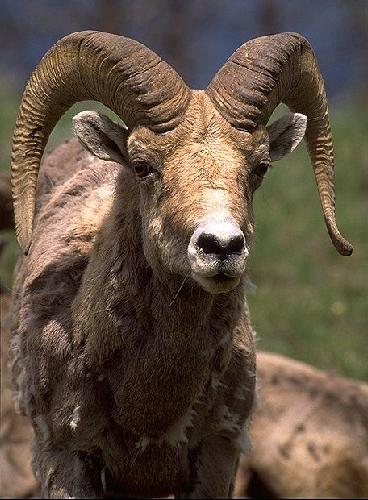 Fully
adult Rocky Mountain bighorn rams stand about a metre at the shoulder
and weigh up to 136 kg, or slightly more when they are in prime physical
condition, in the autumn. Average spring weight of adult rams is about
100 kg, of adult ewes about 63 kg. Dall and Stone sheep are somewhat
smaller, adult males averaging less than 90 kg and adult ewes about
50 kg.
Fully
adult Rocky Mountain bighorn rams stand about a metre at the shoulder
and weigh up to 136 kg, or slightly more when they are in prime physical
condition, in the autumn. Average spring weight of adult rams is about
100 kg, of adult ewes about 63 kg. Dall and Stone sheep are somewhat
smaller, adult males averaging less than 90 kg and adult ewes about
50 kg. 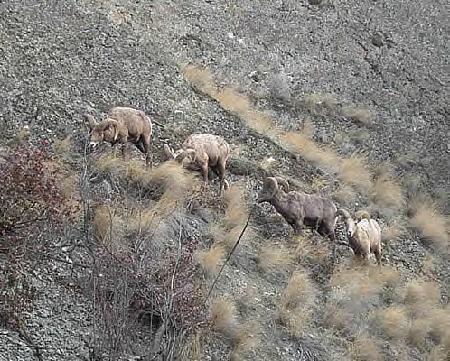 The
pelage, or coat, of wild sheep is short and coarse, never fine and woolly,
as in domestic sheep. In late summer and fall, bighorn sheep, particularly
the rams, are beautifully clothed in a rich brown coat with white muzzle,
white rump patch, and white trim outlining the back of all four legs.
By spring, the brown coat has faded, owing to breakage of the brittle
hair tips, to a drab gray-brown. Once a year, usually about June or
July, sheep shed their hair, and until the new coat grows in, they have
a scruffy, bedraggled appearance, with patches of matted old hair hanging
loosely about them.
The
pelage, or coat, of wild sheep is short and coarse, never fine and woolly,
as in domestic sheep. In late summer and fall, bighorn sheep, particularly
the rams, are beautifully clothed in a rich brown coat with white muzzle,
white rump patch, and white trim outlining the back of all four legs.
By spring, the brown coat has faded, owing to breakage of the brittle
hair tips, to a drab gray-brown. Once a year, usually about June or
July, sheep shed their hair, and until the new coat grows in, they have
a scruffy, bedraggled appearance, with patches of matted old hair hanging
loosely about them.  Lambs
are born between early May and mid-June. Usually one lamb is born per
ewe, although twins occur occasionally. Ewes retire from their flock
to a secluded gully or canyon to have their lamb, which can readily
follow its mother after 2 or 3 days, although somewhat unsteadily. Sheep
are sociable, and the ewe quickly rejoins her flock of 10 or more ewes,
lambs, yearlings, and immature rams.
Lambs
are born between early May and mid-June. Usually one lamb is born per
ewe, although twins occur occasionally. Ewes retire from their flock
to a secluded gully or canyon to have their lamb, which can readily
follow its mother after 2 or 3 days, although somewhat unsteadily. Sheep
are sociable, and the ewe quickly rejoins her flock of 10 or more ewes,
lambs, yearlings, and immature rams. 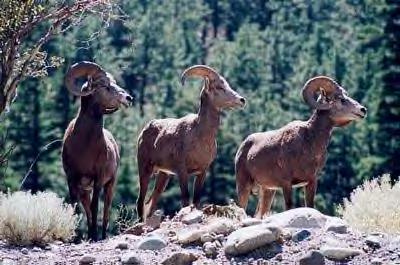 Grasses
and similar low-growing plants are the staple food of wild sheep. Twigs
of trees and shrubs, so important to deer and moose, are seldom eaten.
Wheatgrass, fescues, bluegrasses, and sedges are important foods. Clover,
peavine, lupines, pasture sage, dwarf willow, and cinquefoil are eaten
where available. Mineral licks containing salts are eagerly sought,
mainly in spring and summer.
Grasses
and similar low-growing plants are the staple food of wild sheep. Twigs
of trees and shrubs, so important to deer and moose, are seldom eaten.
Wheatgrass, fescues, bluegrasses, and sedges are important foods. Clover,
peavine, lupines, pasture sage, dwarf willow, and cinquefoil are eaten
where available. Mineral licks containing salts are eagerly sought,
mainly in spring and summer. 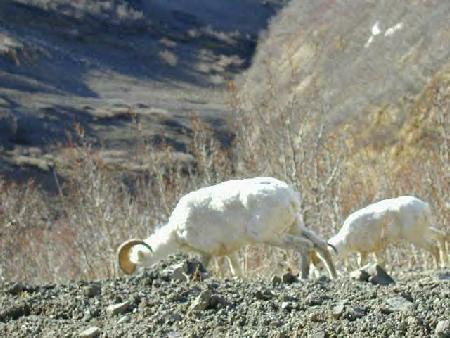 There
were probably over one million bighorns in North America at the start
of the 19th century. The present population is about 25 000. Dall and
Stone sheep numbers are not well known, but have changed little since
pre-settlement times. The principal bighorn decline was from 1850 to
1900 – a result of diseases introduced by domestic sheep, loss
of ranges to livestock, and excessive hunting by man.
There
were probably over one million bighorns in North America at the start
of the 19th century. The present population is about 25 000. Dall and
Stone sheep numbers are not well known, but have changed little since
pre-settlement times. The principal bighorn decline was from 1850 to
1900 – a result of diseases introduced by domestic sheep, loss
of ranges to livestock, and excessive hunting by man.